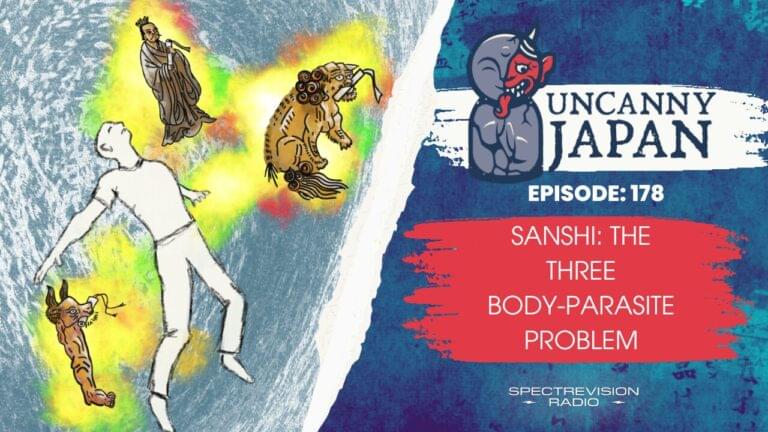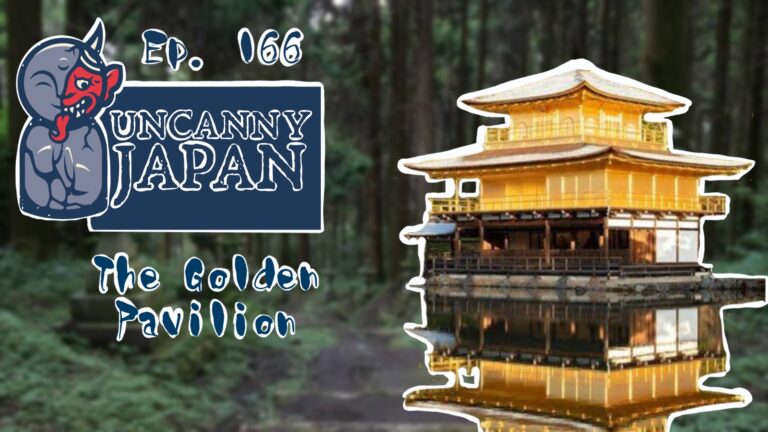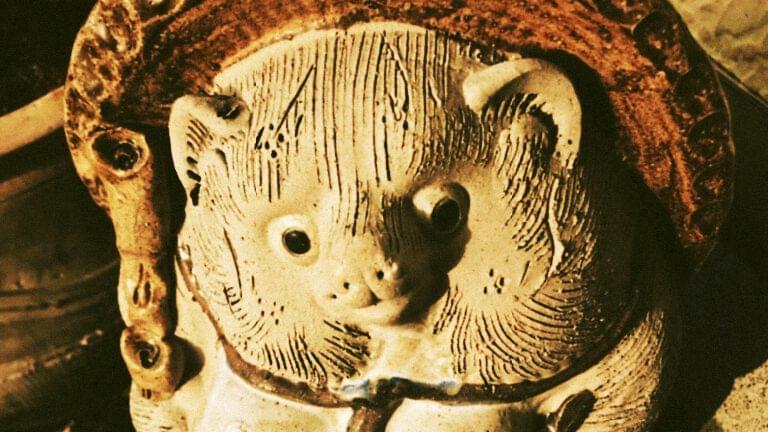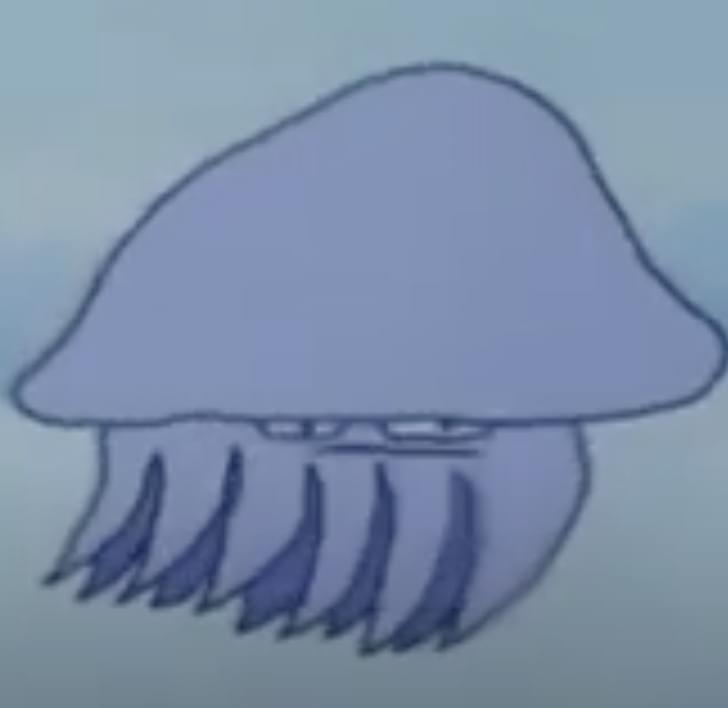Hey, hey, this is Thersa Matsuura and you’re listening to Uncanny Japan, the podcast about the more obscure corners of Japanese culture, mysterious yōkai, fascinating folktales, endearing superstitions, and more. It’s officially October and to gear up for this spooky season, today I’m going to read you an article I wrote for Sotheby’s back about five years ago. It’s about the Nihon Sandai Kaidan, or Japan’s three great ghost stories. And those stories are about the three lovely ladies, Okiku, Oiwa, and Otsuyu.
I told Okiku’s story in episode 25. Her tale is often called Bancho no Sarayashiki, the Dish Mansion of Bancho. Oiwa, you heard about in episode 42. Her tale is usually called Yotsuya Kaidan. And finally, Otsuyu’s utterly bizarre story, I’ll get to that one next episode, when I’ll read Lafcadio Hearn’s version called Botan Dorou, the Peony Lantern. So let me tell you a little about not just these ghostly, vengeful spirits, but a bit about the artist who depicted them as well. The images I mention, I’ll put up in the show notes on the Uncanny Japan website.
Japan’s Three Great Ghost Stories
The Ukiyo-e tradition offers a glimpse into popular culture during the Edo period, 1603 to 1867. These pictures of the floating world were meant to amuse, depicting scenes of everyday life, culture, and literature. Great masters of woodblock printing and painting, such as Katsuhiko Hokusai, Tsukioka Yoshitoshi, and Shunbai Saihoku-e, would tell stories through their art, at times delving into kaidan, uncanny tales of the supernatural. Of these, the Nihonsandai Kaidan are some of the most well-known.
Imagine an apparition of a young woman with long hair, hanging loose and tangled. She’s wearing a white kimono. She has no feet. This archetypal image traces its roots back hundreds of years in Japan, to depictions in art and on stage. Such ghost stories were popular in kabuki theater, and often appeared as subjects of many ukiyo-e, as well as other paintings. These spectral images persist to this day, and can send chills up the spine.
Onryō: Vengeful Spirits
Of all the Japanese ghosts, there is one kind of spirit that is particularly frightening: onryō. Onryō are vengeful spirits that are almost always women who have died experiencing betrayal, rage, hate, and jealousy, and have returned to exact revenge. Mention of onryō in Japan would immediately bring to mind Otsuyu, Okiku, and Oiwa, whose tragic tales would make up the Nihonsandai Kaidan, Japan’s three great ghost stories.
Otsuyu: The Peony Lantern
Tsukioka Yoshitoshi’s woodblock print of Botan Dorou is part of his final major woodblock print series, New Forms of Thirty-Six Ghosts, which he worked on from 1889 until his death. Yoshitoshi is regarded as one of the last great masters of ukiyo-e, best known for his work 100 Aspects of the Moon. Toward the end of his career, during Japan’s rapid modernization, Yoshitoshi began to struggle from psychological stress, and after several episodes of breakdown, he was committed to Sugamo Asylum in 1892.
Although the New Forms of Thirty-Six Ghosts were created at the time of Yoshitoshi’s mental decline, the image of Botan Dorou still shows the artist’s mastery of composition and imagination. It depicts the beautiful Otsuyu, accompanied by her otherworldly servant who is holding a peony lantern.
Otsuyu’s Tale
Otsuyu’s story begins with a widower named Shinojo Ogiwara. One night, Ogiwara noticed a beautiful woman walking along a dark road. Beside her was a servant who was lighting the way with a paper lantern in a peony design. Ogiwara approached the beautiful lady and asked her name, which was Otsuyu, morning dew. He then invited her to his home, and to his surprise, she agreed to spend the evening, only to bid him farewell just before sunrise.
The next evening, she appeared again and once more stayed with him until dawn. These nightly visits continued thus, with Ogiwara so consumed by an obsession for Otsuyu that he isolated himself in his home and stopped going out altogether.
After twenty days, a neighbor grew concerned over Ogiwara’s disappearance. Upon again hearing laughter and singing coming from Ogiwara’s home, the neighbor peeked into his room, and there he saw a shocking sight. Otsuyu was not a young maiden, but a skeleton.
Upon learning this truth the next day, Ogiwara hurried to a nearby temple where a monk showed him Otsuyu’s grave. There on the grave lay a tattered paper lantern with a peony design. The monk gave Ogiwara a magic charm which would ward Otsuyu’s ghost away from his home.
Although the charm worked well, Ogiwara was already entranced and just couldn’t forget Otsuyu. One night, he got drunk and he visited her grave. There, Otsuyu was waiting for him, as beautiful and bewitching as ever. Ogiwara didn’t return home for many days, prompting the concerned neighbor and monk to open up Otsuyu’s grave. There, they found Ogiwara lying lifeless, wrapped up in the arms of a skeleton.
Okiku: The Ghost at the Well
In The Ghost of Okiku at Sarayashiki, Yoshitoshi references the eerie and woeful tale of a servant as she stands over a well, the place where her life ended. Despite the gruesome story, Yoshitoshi manages to convey Okiku’s sad and ethereal spirit with great sensitivity.
Okiku’s Story
Okiku’s story starts long ago, when as a servant woman, she was hired to wash the dishes for the of Himeji Castle. Okiku’s beauty caught the eye of the samurai named Aoyama, and he became obsessed with her. He courted the young servant, but to no avail.
One day, as a desperate ploy to possess her, Aoyama came up with a plan. He hid a priceless dish, one of ten, belonging to the Lord, and then questioned Okiku, what have you done with the tenth plate? Knowing such an offense was punishable by death, Okiku furiously searched for it everywhere, but could not find the missing dish. Aoyama calmly watched on.
Finally, he made her an offer. If she were to become his mistress, he would tell the Lord she was not to blame. Okiku again declined. At this, Aoyama flew into a rage and ordered the young dishwasher, beaten and thrown into the well.
Soon after her untimely death, Okiku’s ghost could be seen wandering the castle, searching for the lost plate. You could hear her counting. One, two, three, four, five, six, seven, eight, nine. And when no tenth plate was found, she’d let out a blood-curdling scream.
It is said that even today, those who overhear her counting might fall very ill, and those who hear her make it all the way to nine will soon die.
Oiwa: The Ghost of Yotsuya
Of the three great ghosts, the last and probably best known is Oiwa. In the work of Shunbaisai Hokuei, Oiwa haunts her treacherous husband appearing in the form of a paper lantern. Hokuei was a leading artist of the Ōsaka School of Printmakers. He often focused on subjects relating to kabuki theater, and his art would typically show figures in dramatic poses.
In this haunting image, the masterless samurai Iemon is ready to draw his sword on the apparition of his former wife, who eventually causes him to go mad.
Oiwa’s Tale
The story known as Yotsuya Kaidan tells this sad tale of Oiwa who was married to Iemon, a masterless samurai. Although her husband was down on his luck, Oiwa remained a devoted and loving wife and worked hard to support him.
Meanwhile, Iemon befriended an elderly and very rich Dr. Ito, whose granddaughter, Oume, fell in love with the out-of-work samurai. As a doting grandfather, Ito would use all his power to grant Oume happiness, so he offered Iemon great wealth, a life of ease, and Oume’s hand in marriage. That is, if Iemon would rid himself of Oiwa.
Iemon fell to this temptation. Putting their plan to action, Ito gave Iemon a mysterious powder to poison Oiwa, slipping it into her food day by day. Oiwa slowly became weaker and weaker. The poison ate away at her beauty. By the time she discovered her husband’s insidious plan, it was too late.
Feeling ill and exhausted, she noticed some of her fallen hair on the tatami mats, prompting her to comb and pin up her long tresses. As she sat before the mirror, she caught sight of her hideous disfigured face and collapsed. The shock was her undoing.
In her last moments of life, Oiwa managed to curse her deceitful husband, and in death, her vengeful spirit would bedevil Iemon. He would see her mutilated image everywhere, appearing in the faces of people he would encounter, and even materializing in lanterns. It was not long before Iemon would descend into madness.
Legacy of Japan’s Three Great Ghost Stories
Onryō, or vengeful ghosts. In particular, the stories of Otsuyu, Okiku, and Oiwa captured popular imagination during the Edo period, and have appeared again and again in art, on stage, and in stories. These tales have been retold in countless variations.
Today, you only have to look as far as the big screen with movies such as The Ring or Juon to see modern-day entertainment that play homage to these three onryō.
Thank you for listening. Thank you for picking up the Book of Japanese Folklore and for reviewing it, and for adding Knights vs. samurai to your pull list. Stay safe and well, and I’ll talk to you again in two weeks.






